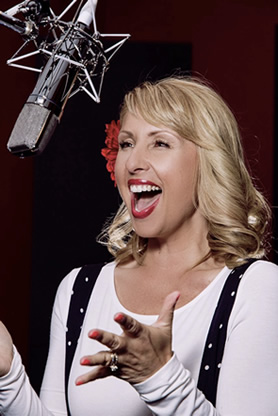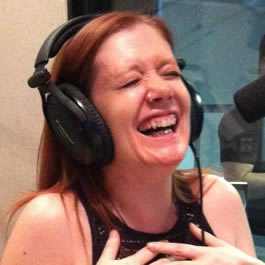
TVAS student, voice actor, & jack-of-all trades Duston Frank.
Jumping into a live, directed VO session can be super nerve-wracking, no matter how much experience you have. Those nerves are good news—they mean you care and want to do a good job!
But nerves often come from the unknown. What exactly happens in a live voiceover session? What do you do?
Here’s what to expect when you’re expecting…a directed voiceover session. (…no? Too “dad joke-y? We’ll workshop it, it’s fine.)
BEFORE THE SESSION
First, the client will schedule a recording date and time with you. Make sure you know their time zone! And always include your time zone so they know if you’re on the other side of the country (or the world!).

TVAS founder, VO pro, and walking beam of sunshine Melissa Moats.
Make sure to prep before your session starts! Melissa wrote an awesome breakdown of how to get session-ready!
I always set things up 15-20 minutes before my live sessions start because a) I am neurotic and paranoid and perpetually distrustful of technology and its constant efforts to thwart me and b) I want to make sure everything’s workin’ so that by the time I connect with a client, it’ll be smooth sailing.
DURING THE SESSION
When you connect with your client at the time of the session, sometimes there are multiple people on the line. These can include the producer, account manager, copy writer, creative director, audio engineer, and more. Everyone will introduce themselves, so make sure you take notes! You’ll want to know who’s who.
And when you introduce yourself, thank them for choosing you for their project! Gratitude goes a long way. Let them know you appreciate it.
Once introductions are over, generally (and that’s the key word here, because sessions can work differently depending on the client), things go down like this:
The producer—or whoever is working directly with you—will talk with the client/everyone on the call to confirm that the direction in your audition is the same direction they’d like you to bring to your read during the session. The client might talk directly to you to give you to discuss the project in detail, and to give an idea of what they’re going for, read-wise.

TVAS coach and A+ giggler, Shelley Avellino.
When it comes to your performance, if you’ve taken classes with us here at TVAS, we format our direction to mirror actual, real-world direction. Our classes run a lot like live sessions, with a bit more teaching involved, of course…in a real session, a producer won’t teach you how to give them what they want. They hired you because they expect you already know how to deliver! (That’s why classes and practice are so important!)
Every director’s, well…directing style is different. Some are very warm and descriptive; some are vague and may not know what they want; others get straight to the point. If you’ve studied with us, we’ve prepped you to adapt to all different kinds of direction styles!
Either you or the producer will call out the takes. Keep track! If you’re in charge of marking the takes, call ‘em out before you start your read: “Take one, *insert read here*” The client may be taking notes and could ask you eight takes in, “Oooh, wait, can you play back take four for us?” Labeling as you go saves you a lot of time.
Speaking of playback, make sure you know how to edit and play back your audio for the client on the fly if they request it! It happens! A client may say, “Hey, can you edit in the last line from take 8 into take 4? We want to hear what that sounds like.” Familiarize yourself with your recording software so you can make quick changes if the client asks for them while on the line.
AFTER THE SESSION
The client will let you know when they’ve got what they need! Before you sign off, make sure you thank them again, and let them know that you’re there for them if they need any changes to the audio. The more accessible you are, the easier it is for them…and, potentially, the more likely they are to hit you up for future VO work!
SAVE YOUR BACKUP RECORDING. Save, save, save! Did I mention save? Save it immediately after you hit “stop.” If there’s a moment when my clients are discussing potential changes among themselves during the session, I’ll quickly stop my recording, save it, and then hit “record” again.
If your client captured your audio via Source Connect, you won’t need to send them any audio—they’ve already got it. (But keep that backup file JUST IN CASE. You never know if you might need it.)

TVAS coach, improv expert, and character voice actor Brent Mukai.
Remember: they want raw, unprocessed audio, so no fancy fiddlin’ with that file! Usually, I just de-breath the audio and send it their way, and sometimes, they don’t even want me to de-breath it (they’ll tell you if that’s the case.) They usually need a WAV file, or occasionally an AIFF file. Make sure you’re recording in a high-quality format!
Always send a follow up email! This should also include a link to the audio from your session. Thank them again, let them know the audio is attached, and reiterate that you’re on standby if they need revisions.
Unless otherwise specified by the client, I always include my invoice along with the session audio. It’s one less thing for me to do later!
The client will usually contact you in a few days with an update—“It works great!” or “Still waiting to hear back from our editors,” or, “We changed one word in this line—can we get a quick pickup?”
If they go radio silent, wait a week and then give them a gentle nudge. People get busy, but 99% of the time, they’ll get right back to you.
And that’s all there is to it! When it comes to live sessions, rest easy knowing that you’ve got this. Be confident in your skills as a VO pro and be willing to collaborate and adapt so your client leaves happy–and, hopefully, wanting to hear more from you!
…Did I mention save your audio?
And for goodness’ sake, don’t forget to hit record!